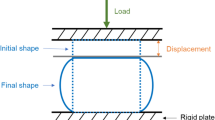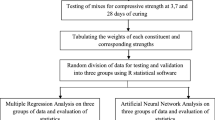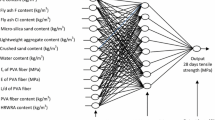Abstract
A tool to predict the tensile properties of cork was applied in order to be used for material and application selection. The mechanical behaviour of cork under tensile stress was determined in the tangential and axial direction. Cork planks of two commercial quality classes were used and samples were taken at three radial positions in the planks.For the construction of the predictive model, nine properties were measured: mechanical properties (Young’s modulus, fracture stress and fracture strain) and the physical properties (porosity, number of pores, density, approximation of the pores to elliptical and circular shape and distance to the nearest pore). The aim of this research work was to predict the mechanical properties from the physical properties using neural networks.Initially, the problem was approached as a regression problem, but the poor correlation coefficients obtained made the authors define a classification problem. The criterion used for the classification problem was the test error rate, training the neural network with a variety of neurons in the hidden layer until the minimum error was achieved. The influence of each individual variable was also studied in order to evaluate their importance for the prediction of the mechanical properties.The results show that the Young’s modulus and fracture stress can be predicted with an error rate in test of 10.6 and 10.2 %, respectively, being the measure of the approximation of the pores to elliptical shape avoidable. Regarding the fracture strain, its prediction from physical properties implies an excessive error.


Similar content being viewed by others
References
Anjos O, Pereira H, Rosa ME (2008) Effect of quality, porosity and density on the compression properties of cork. Holz Roh Werkst 66(4):295–301
Anjos O, Pereira H, Rosa ME (2010) Tensile properties of cork in the tangential direction: variation with quality, porosity, density and radial position in the cork plank. Mater Des 31(4):2085–2090
Anjos O, Pereira H, Rosa ME (2011a) Tensile properties of cork in axial stress and influence of porosity, density, quality and radial position in the plank. Eur J Wood Prod 69(1):85–91
Anjos O, Pereira H, Rosa ME (2011b) Characterization of radial bending properties of cork. Eur J Wood Prod 69(4):557–563
Anjos O, Rodrigues C, Morais J, Pereira H (2014) Effect of density on the compression behaviour of cork. Mater Des 53:1089–1096
Bishop CM (2008) Neural networks for pattern recognition. Oxford University Press, New York
Dhanalakshmi K, Bhattacharya S (2014) Agglomeration of turmeric powder and its effect on physico-chemical and microstructural characteristics. J Food Eng 120:124–134
Esteban LG, Fernández FG, Palacios P, Rodrigo BG (2010) Use of artificial neural networks as a predictive method to determine moisture resistance of particle and fiber boards under cyclic testing conditions (UNE-EN 321). Wood Fiber Sci 42(3):335–345
García Nieto PJ, Martínez Torres J, Araújo Fernández M, Ordóñez Galán C (2012) Support vector machines and neural networks used to evaluate paper manufactured using Eucalyptus globules. Appl Math Model 36(12):6137–6145
Hagiwara K, Fukumizu K (2008) Relation between weight size and degree of over-fitting in neural network regression. Neural Netw 21:48–58
Haykin S (1999) Neural networks, a comprehensive foundation. Prentice Hall, New York
Heaton J (2012) Introduction to the math of neural networks. Heaton Research, New York
Iglesias C, Martínez Torres J, García Nieto PJ, Alonso Fernández JR, Díaz Muñiz C, Piñeiro JI, Taboada J (2014) Turbidity prediction in a river basin by using artificial neural. Water Resour Manag 28(2):319–331
Iliadis L, Mansfield SD, Avramidis S, El-Kassaby YA (2013) Predicting Douglas-fir wood density by artificial neural networks (ANN) based on progeny testing information. Holzforschung 67(7):771–777
Leahy P, Kiely G, Corcoran G (2008) Structural optimisation and input selection of an artificial neural network for river level prediction. J Hydrol 355(1–4):192–201
MacCulloch WS, Pitts WS (1943) A logical calculus of the ideas immanent in nervous activity. B Math Biophys 5:115–133
Mansfield SD, Iliadis L, Avramidis S (2007) Neural network prediction of bending strength and stiffness in western hemlock (Tsuga heterophylla Raf.). Holzforschung 61(6):707–716
Mansfield SD, Kang KY, Iliadis L, Tachos S, Avramidis S (2011) Predicting the strength of Populus spp. clones using artificial neural networks and ε-regression support vector machines (ε-rSVM). Holzforschung 65(6):855–863
Oliveira V, Knapic S, Pereira H (2012) Natural variability of surface porosity of wine cork stoppers of different commercial classes. J Int Sci Vigne Vin 46(4):331–340
Oliveira V, Rosa ME, Pereira H (2014) Variability of the compression properties of cork. Wood Sci Technol 48(5):937–948
Pereira H (1988) Chemical composition and variability of cork from Quercus suber L. Wood Sci Technol 22(3):211–218
Pereira H (2007) Cork: biology, production and uses. Elsevier, Amsterdam
Pereira H (2013) Variability of the chemical composition of cork. BioResources 8(2):2246–2256
Pereira H, Rosa ME, Fortes MA (1987) The cellular structure of cork from Quercus suber L. IAWA Bull 8(3):213–218
Pereira H, Lopes F, Graça J (1996) The evaluation of the quality of cork planks by image analysis. Holzforschung 50:111–115
Prakash N, Manikandan SA, Govindarajan L, Vijayagopal V (2008) Prediction of biosorption efficiency for the removal of copper (II) using artificial neural networks. J of Hazard Mater 152(3):1268–1275
Rosa ME, Fortes MA (1991) Deformation and fracture of cork in tension. J Mater Sci 26(2):341–348
Schittenkopf C, Deco G, Brauer W (1997) Two strategies to avoid overfitting in feedforward networks. Neural Netw 10(3):505–516
Shabani MO, Mazahery A (2011) The ANN application in FEM modeling of mechanical properties of Al–Si alloy. Appl Math Model 35(12):5707–5713
Yilmaz M, Ertunc HM (2007) The prediction of mechanical behaviour for steel wires and cord materials using neural networks. Mater Des 28(2):599–608
Acknowledgments
C. Iglesias acknowledges the Spanish Ministry of Education, Culture and Sport for her FPU 12-02283 grant. Financial support given by Fundação para a Ciência e a Tecnologia (Portugal), through the funding to Centro de Estudos Florestais (FEDER/POCTI 2010 and Pest-OE-AGR-UI0239-2011). J. Martínez acknowledges the Spanish Ministry of Science and Techonlogy for the funding in the project ECO2011-22650. The authors would like to express their gratitude to Isabele Salavessa (IPCB Languages centre) for the English revision.
Author information
Authors and Affiliations
Corresponding author
Rights and permissions
About this article
Cite this article
Iglesias, C., Anjos, O., Martínez, J. et al. Prediction of tension properties of cork from its physical properties using neural networks. Eur. J. Wood Prod. 73, 347–356 (2015). https://doi.org/10.1007/s00107-015-0885-1
Received:
Published:
Issue Date:
DOI: https://doi.org/10.1007/s00107-015-0885-1




